11 Mythical Japanese Swords: A Journey Through Time and Myth
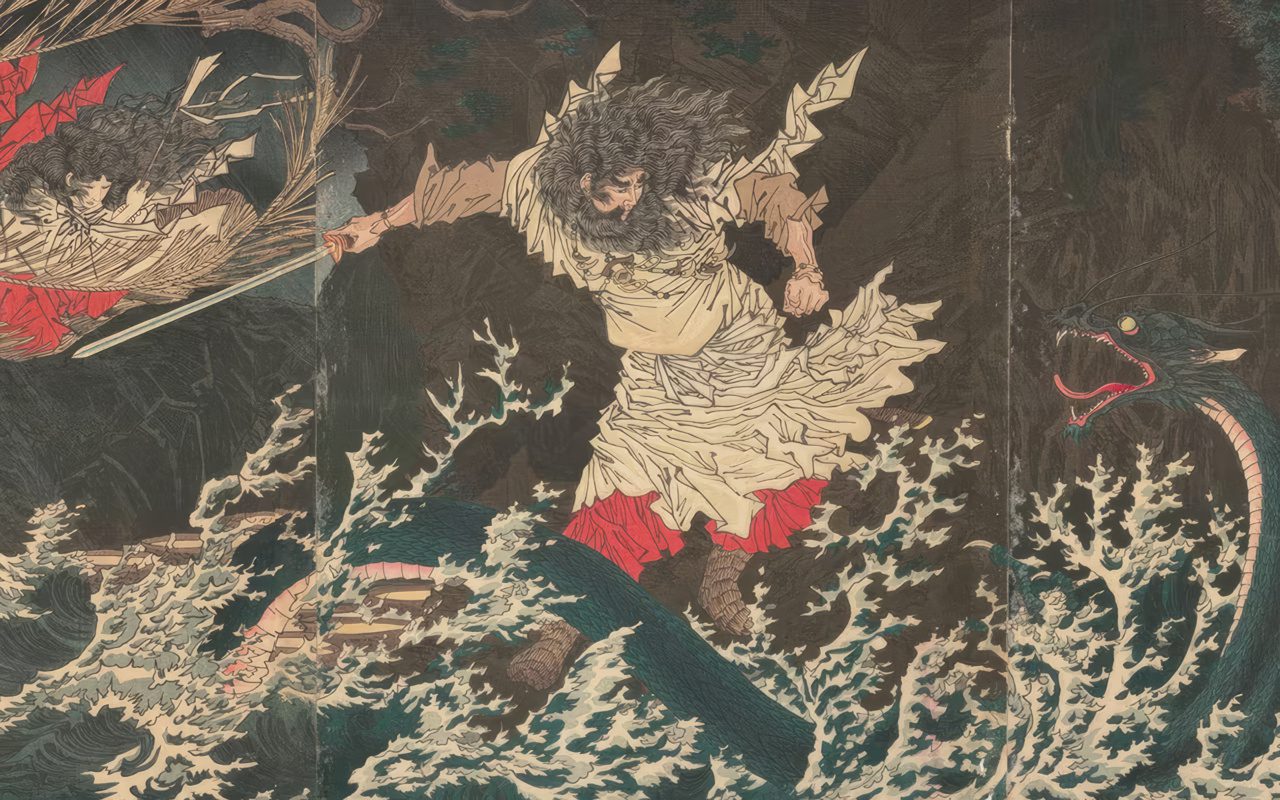
What’s in this article?
The sword has been a powerful symbol in Japan for millenia. Throughout Japanese history, people have attached immense importance and meaning to the sword and incorporated this weapon into their cultural and religious identity. In this article, we will explore the most legendary swords of Japanese mythology throughout this powerful nation’s history.
Japan has a rich tradition of swordmaking. Dating back over 2000 years, Japanese people have embedded swords into their spiritual and cultural beliefs, enshrining these weapons as the most powerful accomplices of heroes and villains. What follows is an exploration of the most famous mythical swords in Japanese history.

1. Ame-no-Habakiri
Used by Susanoo, the Shinto god of storms and the sea, to slay Yamata-no-Orochi, a fearsome eight-headed serpent, the Ame-no-Habakiri is the earliest example we have of a Japanese hero conquering his enemy with a sword. The earliest records of Japan say Ame-no-Habakiri was a longsword (Totsuka-no-Tsurugi).
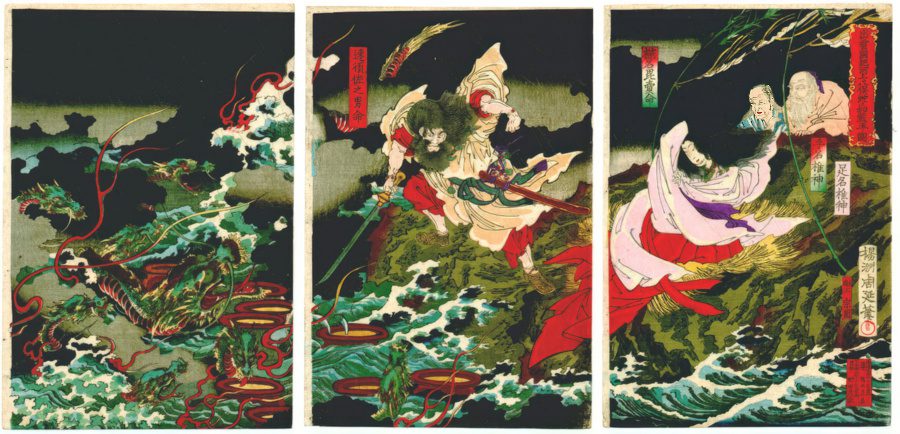
Susanoo came across an elderly couple who were grieving because Yamata-no-Orochi had devoured seven of their eight daughters. The serpent demanded their last daughter, Kushinada-hime, as its next sacrifice. Susanoo agreed to help the couple and defeat the serpent in exchange for Kushinada-hime’s hand in marriage.
Susanoo set up eight vats of potent sake to lure the serpent. As Yamata-no-Orochi became intoxicated after drinking from the vats, Susanoo drew the Ame-no-Habakiri and slew the serpent, cutting off each of its eight heads and tails.
During the battle, Susanoo discovered another legendary sword, Kusanagi-no-Tsurugi, within the tail of Yamata-no-Orochi. This sword later became one of the Three Imperial Regalia of Japan, symbolizing the divine right of the Japanese emperors.
The name “Ame-no-Habakiri” can be translated as “Snake-Slayer of Heaven” or “Heavenly Sword of Snake Slaying.” The sword is often depicted as a powerful and divine weapon in Japanese art, literature, and popular culture. While the exact appearance of the sword varies in different interpretations, it is typically portrayed as a straight, double-edged blade with a simple hilt.
2. Kusanagi-no-Tsurugi
Kusanagi-no-Tsurugi is a national treasure. The most respected sword in Japanese history, its name can be translated to “Grass-Cutting Sword.”
Kusanagi-no-Tsurugi is one of the Three Sacred Treasures, or Imperial Regalia, of Japan. Along with the Yata no Kagami (mirror) and the Yasakani no Magatama (jewel), the sword represents valor, the mirror represents wisdom, and the jewel represents benevolence.

This sword was discovered when Susanoo slayed the eight-headed serpent Yamata-no-Orochi. When the storm god cut off the fourth tail, something chipped his blade. Susanoo pulled Kusanagi-no-Tsurugi out of the monster, and ever since, it has played an important role in Japanese myth.
A popular myth involving this sword is when Susanoo offers it to his sister Amaterasu, the sun goddess, as a reconciliation gift. Susanoo can be violent and destructive, and he scared his sister, forcing her into a cave which caused the earth to descend into darkness and chaos. After she is coaxed out by other gods and goddesses, Susanoo apologizes by offering her this sword.
Another myth this sword appears in is that of the legendary prince, Yamato Takeru. During a grass fire set to kill him, Yamato Takeru used the Kusanagi to cut back the flames, saving himself, and, thus, the sword earned its grass-cutter name.
3. Murasame
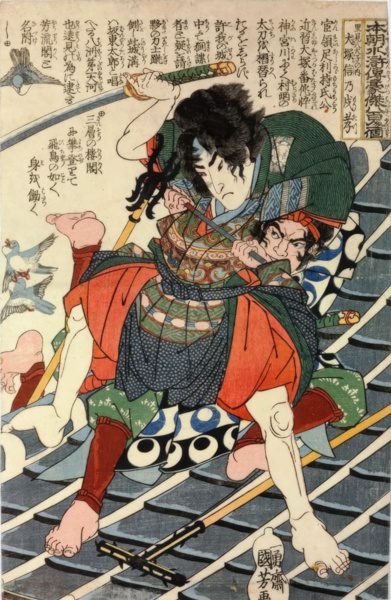
“Murasame” is one of the most legendary Japanese swords. Featured in various forms of Japanese media and literature, Murasame is known for its mythical ability to summon rain. Murasame’s origins are unclear, but it has been mentioned in Japanese folklore since the Asuka period.
The most famous depiction of the Murasame sword is in the novel “Nansou Satomi Hakkenden” by Kyokutei Bakin. In this story, Inuzuka Shino wields the Murasame, a cursed sword that causes anyone cut by it to bleed uncontrollably as if they were drenched by a sudden rain shower.
In other interpretations, especially in more contemporary media like manga, anime, and video games, the Murasame is often portrayed as a “rain-summoning sword.” In the “Akama Ga Kill!” anime, the Murasame is a cursed katana used by Akama that kills enemies with one cut, sending a poisonous curse throughout their body.
4. Dojikiri Yasutsuna
Known as “The Demon Cutter,” Dojikiri Yasutsuna is one of the most famous samurai swords in Japanese history and is considered one of the Tenka Goken (“Five Swords under Heaven”).
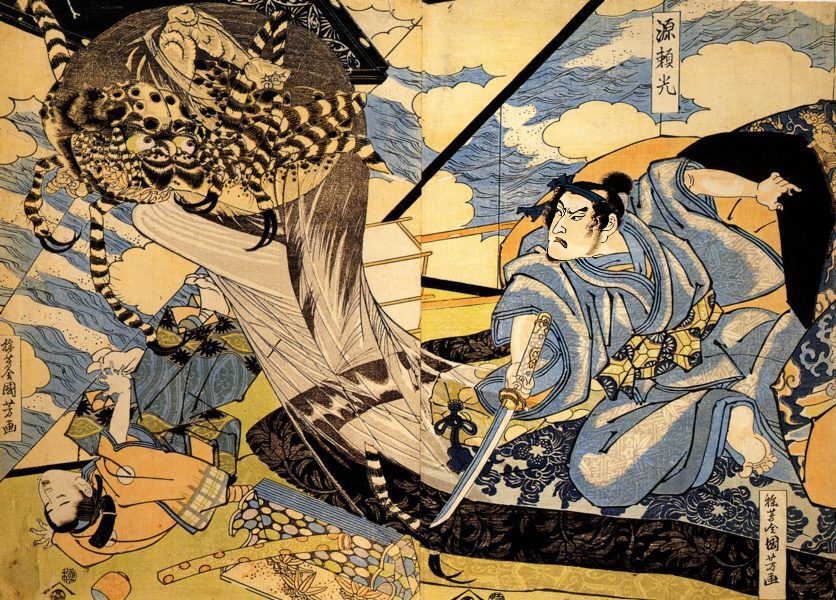
The sword was reportedly forged by Yasutsuna, one of the greatest swordsmiths of the Heian period (794 – 1185 CE). Yasutsuna is recognized as the founder of the Hoki school of swordsmithing, and his works are praised for their exceptional quality and beautiful craftsmanship.
Dojikiri Yasutsuna gets the “Demon Cutter” name from the legendary feat of Minamoto no Yorimitsu, also known as Minamoto no Raikou, a military commander of the Heian period. According to the legend, Raikou and his four guardian knights, known as the Shitennō, set out to exterminate the infamous oni (demon or ogre) Shuten-doji, who was terrorizing the area around Kyoto.
Disguised as Buddhist monks, Raikou and his men were invited into Shuten-doji’s lair, where they served the oni drugged sake and waited for him to fall unconscious. Once the oni was incapacitated, Raikou drew the Dojikiri Yasutsuna and beheaded Shuten-doji. It is said that the sword cut was so clean that Shuten-doji did not realize he had been beheaded until he tried to move.
Dojikiri Yasutsuna is revered as a masterpiece of Japanese swordsmithing. It is currently designated as a National Treasure of Japan and is stored in the Tokyo National Museum.
5. Onimaru Kunitsuna

Another Tenka Goken sword associated with the legendary warrior Minamoto no Raikou is the Onimaru Kunitsuna. Forged by Kunitsuna, a superior swordsmith of the Osafune school, the name of the sword translates to “Demon Circle” which refers to its ability to vanquish supernatural entities. Onimaru is also one of the “Five Swords Under Heaven” and is widely respected in Japan.
According to a tale, one night, an oni haunted Raikou’s bedside while he was ill. His loyal retainer, Watanabe no Tsuna, stood guard over him with the sword. When the oni attacked, Tsuna fought it off with the sword, saving his master. After the incident, the sword was named Onimaru Kunitsuna, often shortened to Onimaru.
6. Juzumaru Tsunetsugu
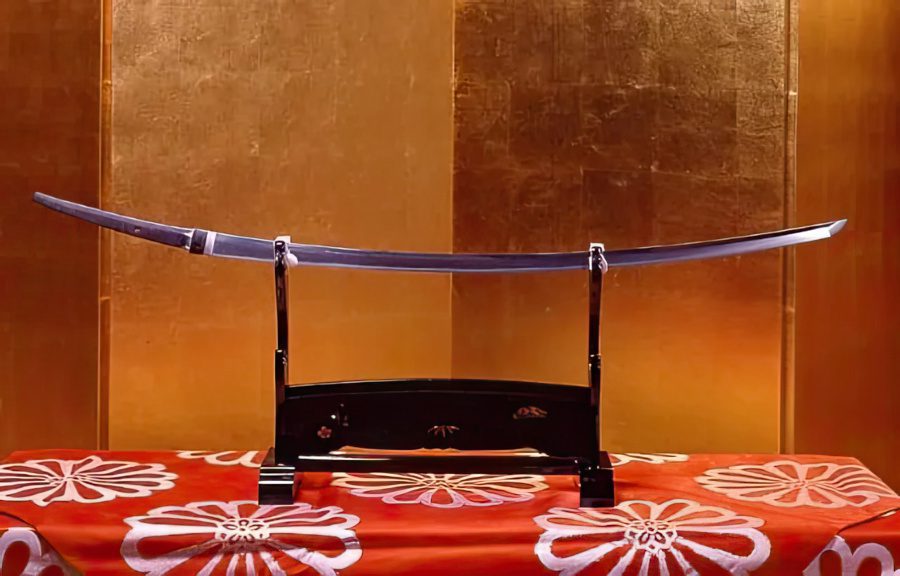
Another of Japan’s Tenka Goken is the Juzumaru Tsunetsugu. This sword is a sacred relic of Nichiren Buddhism, and the monks who used it wrapped the handle with a rosary (Juzu) to ward off evil spirits in the 13th century.
The sword is believed to have been forged by Tsunetsugu Ko-Aoe, the famous swordsmith from the Ko-Aoe school. This sword is the longest of the Tenka Goken at 32 inches (81 cm).
This important cultural icon of Japan is currently kept at the Honkōji temple and is displayed every year on November 3rd.
7. Mikazuki Munechika
The Mikazuki Munechika is one of the most famous and revered swords in Japanese history, also sharing the status of Tenka Goken. The sword was crafted by the legendary swordsmith Munechika during the late Heian period (794–1185 CE). Munechika was known for his exceptional skill, and the Mikazuki Munechika is considered his finest work.
“Mikazuki” name refers to the crescent moon qualities of the sword. The curvature of the sword, the crescent-moon shape seen in the hamon (the visual effect created on the blade by the hardening process), and the sleek, silvery sheen of the blade all contribute to the sword’s distinctive name.
According to a famous legend, Munechika was commissioned to forge a sword, but he realized that the task was too great for him to undertake alone. Munechika was concerned because, traditionally, swordsmithing was done by a team of two masters, but he was the only master smith available at the time.
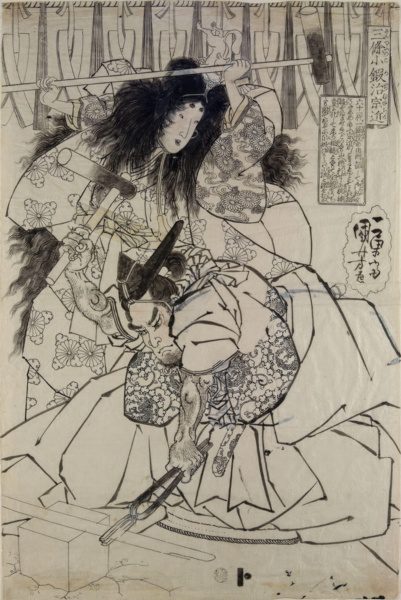
While Munechika was pondering his predicament, a fox spirit known as Inari appeared. In Japanese folklore, Inari is the kami (spirit, god, or deity) of fertility, rice, tea, sake, agriculture, industry, and general prosperity. Foxes are often seen as Inari’s messengers or avatars.
In the form of a young boy, Inari offered to assist Munechika in his task. The swordsmith gratefully accepted the offer, and together they forged the Mikazuki Munechika, one of the most beautiful and legendary swords in Japanese history.
This story has been depicted in various forms of art, including the famous print by Utagawa Kuniyoshi pictured above, showing Munechika forging the sword with the assistance of the fox spirit. The tale adds a mythical and spiritual dimension to the sword, enhancing its status and reputation in Japanese culture.
Today, the sword is designated a National Treasure of Japan and is kept at the Tokyo National Museum.
8. Ōdenta Mitsuyo

The final Tenka Goken sword is Ōdenta Mitsuyo, the greatest of the swords forged by Miike Denta Mitsuyo. Along with the Onimaru and the Futatsu-mei sword, The Ōdenta was one of the founding regalias for the Ashikaga Shogunate.
This is the shortest and widest sword of the Tenka Goken at 26 inches (66 cm). It is said this sword healed a princess of the Maeda clan after she fell seriously ill. The sword was placed near her bedside, and she miraculously recovered. Ever since then, the Maeda family has owned this sword, and it is rarely put on display.
9. Honjo Masamune
The Honjo Masamune is one of the most famous and significant swords in Japanese history. It was created by Goro Nyudo Masamune, who is widely considered to be Japan’s greatest swordsmith. Masamune lived during the late 13th and early 14th century, during the late Kamakura period.
Masamune’s swords are renowned for their superior beauty and quality. The craftsmanship, balance, and cutting power of his swords are highly praised. They are also known for their unique and beautiful tempering patterns.
The Honjo Masamune, named after Honjo Shigenaga, a general who came into possession of it in the 16th century, has a storied history. Shigenaga acquired the sword after a fierce battle in 1561 when he defeated an enemy general who wielded the Honjo Masamune. Despite being greatly valued by Shigenaga, he was forced to sell it due to financial difficulties.

The sword then passed through several hands, including various daimyo (feudal lords), and eventually came into possession of the Tokugawa shogunate, the ruling power in Japan from 1600 to 1868. The Honjo Masamune became a symbol of the shogunate, passed down as an heirloom through successive shoguns.
After the fall of the shogunate in the late 19th century, the sword was still kept by the Tokugawa family. However, its whereabouts became unknown after World War II. In an attempt to prevent potential use of civilian-owned swords as weapons, the American occupation forces ordered a mass confiscation of swords in 1945.
The Honjo Masamune was given to a police station by Tokugawa Iemasa, and from there, it was reportedly handed over to Sergeant Coldy Bimore, an American stationed in Japan. Since then, the sword has been missing and its current location remains one of the great mysteries in the world of Japanese swords.
The disappearance of the Honjo Masamune is considered a significant loss, as it represented the pinnacle of Japanese sword craftsmanship and a vital part of Japan’s cultural heritage. Other Masamune swords exist and are designated as national treasures of Japan.
This sword is a great example of how Japan’s culture takes a real sword and infuses it with mythological properties. Swords of great craftsmen are so exquisitely made that they transcend reality and acquire legendary status.
10. Tsurumaru Kuninaga
Another of these real swords that have taken on mythological qualities is the Tsurumaru Kuninaga. Forged by the famous swordsmith Kuninaga, the name “Tsurumaru” (Crane circle) comes from the sword’s unique handguard, which features a design of a crane in a circle. In Japanese culture, the crane is a symbol of good fortune and longevity, adding an element of spiritual significance to the sword.
The sword is a type of tachi, which was often used by samurai in ancient Japan. Tachi are generally longer and more curved than the later katana, and they were typically worn hanging from the belt with the cutting edge facing down.
Over the centuries, the Tsurumaru Kuninaga has been passed down through several owners. It’s known to have once been in the possession of the Uesugi clan, a powerful family during Japan’s Sengoku period (1467-1615 CE).
The Tsurumaru Kuninaga is known for its exceptional beauty and the high level of craftsmanship that went into its creation. The sword is now designated as an Important Cultural Property in Japan and is kept at the Tokyo National Museum.
While the Tsurumaru Kuninaga is not associated with a specific legend or myth like some other famous Japanese swords, it has been featured in popular culture, such as video games and anime. For example, it appears as a character in the game “Touken Ranbu,” where historical swords are depicted as attractive young men.
11. Kotetsu Swords
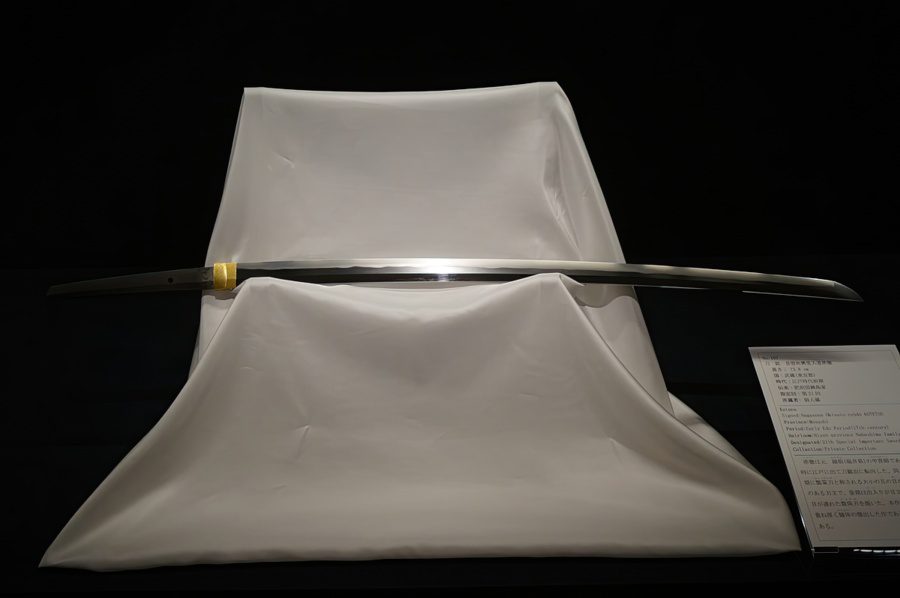
Kotetsu swords refers to the famous swords crafted by the renowned Japanese swordsmith, Nagasone Kotetsu. Kotetsu lived during the Edo period (1603-1868), a peaceful era in Japanese history marked by the rule of the Tokugawa shogunate.
Kotetsu initially made a living as an armor maker, but he shifted to sword crafting later in his life. His swords quickly gained fame for their superior quality, strength, and sharpness. Kotetsu’s blades are known for their distinctive hamon (temper line), which often features a pattern resembling a string of beads.
While not associated with a particular myth or legend, Kotetsu’s swords have gained a mythical reputation due to their quality and the stories surrounding them. For example, there’s a famous anecdote where a blade by Kotetsu cut through the helmet of an opponent without any damage to the sword itself, demonstrating its extraordinary sharpness and durability.
In pop culture, “Kotetsu” often appears as a sword with its own character and story, especially in anime, manga, and video games, also appearing in Touken Ranbu.
Final Note
Swords are adored and respected in Japanese culture and religion. We hope this article has offered you some insight into how powerful these swords are in the collective Japanese imagination. Thank you for reading!





